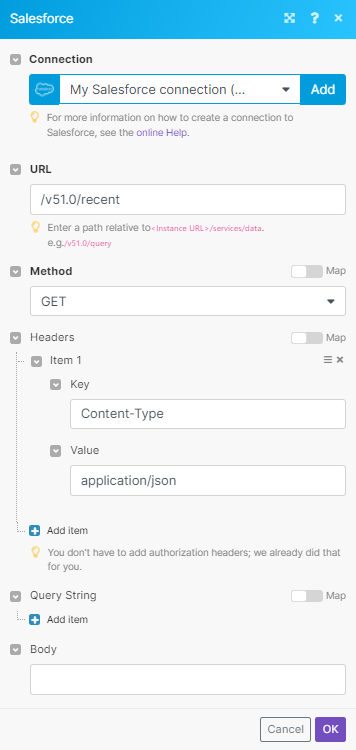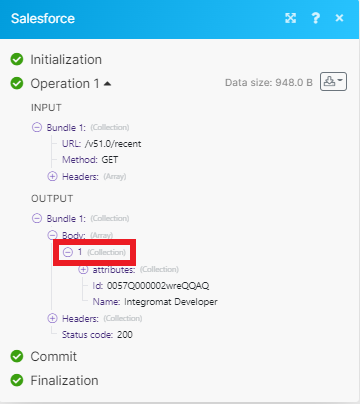Salesforce¶
The Salesforce modules allow you to create broadcast messages, create and modify records and jobs, and make API calls from your Salesforce account.
Getting Started with Salesforce¶
Prerequisites
- A Salesforce account
In order to use Salesforce with Ibexa Connect, you must first have a Salesforce account. If you do not have one, you can create one at salesforce.com.
Connecting Salesforce to Ibexa Connect¶
Note
Not all editions of Salesforce have API access. See here for more information.
-
Go to your Ibexa Connect scenarioand choose the Salesforce module you want to use.
-
Next to Connection, click Add.
-
Choose a name for your Salesforce connection.
-
Choose whether you want to use a Salesforce Sandbox environment. Click Save.
-
Allow Ibexa Connect access to your account by cicking Allow.
-
Log in to your Salesforce account in the pop-up window.
You have successfully established the connection.
Record¶
Watch Records¶
Triggers when a record is created or updated in an object.
Watch Records |
Select the option to watch the records:
|
Type |
Select the type of object whose records you want to watch. |
Limit |
Enter the maximum number of records Ibexa Connect returns during one scenario execution cycle. |
Search Records¶
Searches for records in an object using a Salesforce Object Search Language (SOSL) query.
| Search By | Select how you would like to search the records. * User defined string Select the type of string you want to search with and enter your query parameters. See here for more information about search possibilities. * Using SOSL Enter the SOSL query. To create your own, use the Salesforce SOSL syntax. You can find example test searches here. Note: The value of the parameter RETURNING influences the output of the module. If you use LIMIT, Ibexa Connect ignores the settings made for the Maximum number of returned records. If you don't set any limit, Ibexa Connect inserts the value LIMIT = Maximal number of returned records unless you disable the limit. |
| Limit | Enter the maximum number of records Ibexa Connect returns during one scenario execution cycle. |
List/Search Records¶
Lists or searches for records in an object using a filter or a Salesforce Object Query Language (SOQL) query.
| Search By | Select how you would like to search the records. * Filter Select the type of filter you want to use to search the records. * Using SOQL Enter the SOQL query. To create your own, use the Salesforce SOQL syntax. Note:The value of the parameter RETURNING influences the output of the module. If you use LIMIT, Ibexa Connect ignores the settings made for the Maximum number of returned records. If you don't set any limit, Ibexa Connect inserts the value LIMIT = Maximal number of returned records unless you disable the limit. Note: The max number of returned records by an SOQL query is always 2,000 no matter if you set up a higher Limit below or directly in your SOQL query. This is a limitation on Salesforce's side as outlined here. |
| Limit | Enter the maximum number of records Ibexa Connect returns during one scenario execution cycle. |
Get a Record¶
Gets a specified record in an object.
| Type | Select the type of record you want to retrieve. |
| Record ID | Enter or search for the ID of the record you want to retrieve. |
Create a Record¶
Creates a new record in an object.
| Type | Select the type of record you want to create. Enter the details in the fields that auto-populates based on your selection. Note: For more information, please see the Salesforce Field Reference Guide. |
Update a Record¶
Updates an existing record in an object.
| Type | Select the type of record you want to update. Enter the details in the fields that auto-populates based on your selection. Note: For more information, please see the Salesforce Field Reference Guide. |
Record ID
Enter the ID of the record you want to update.
Upsert a Record¶
Upserts a record.
| Type | Select the type of record you want to upsert. This only shows types which are both creatable and updatable. Enter the details in the fields that auto-populates based on your selection. Note: For more information, please see the Salesforce Field Reference Guide. |
Record ID
Enter the ID of the record you want to upsert.
Delete a Record¶
Deletes a record.
| Type | Select the type of record you want to delete. |
| Record ID | Enter the ID of the record you want to delete. |
Bulk Job¶
Watch Jobs¶
Triggers when a bulk data job is created.
Job Type |
Select the type of job you want to watch.
|
PK Chunking |
Choose whether to filter jobs with PK chunking enabled. |
Limit |
Set the maximum number of jobs Ibexa Connect returns during one scenario execution cycle. |
List Jobs¶
Retrieves all bulk data jobs in the organization.
Job Type |
Select the type of jobs you want to list.
|
PK Chunking |
Choose whether to list jobs with PK chunking enabled. |
Query Locator |
Enter a query locator value to get a specific set of job results. |
Limit |
Set the maximum number of jobs Ibexa Connect returns during one scenario execution cycle. |
Create a Job¶
Creates a new bulk data job.
Type |
Select the type of job you want to create. |
File |
Name Enter the file name, including the extension. For example: Data Enter any additional job data. |
Column Delimiter |
Select the column delimiter used for CSV job data. The default value is |
Line Ending |
Select the line ending, marking the end of a data row. The default is |
Complete/Abort a Job¶
Completes or aborts a job.
Note
If you complete a job, Salesforce queues the job and uploaded data for processing, and you can’t add any more job data. If you abort a job, the job does not get queued or processed.
| Job ID | Select the ID of the job you want to complete or abort. |
| State a Method | Select the action you want to perform. You can abort a job if you created it or if you have the “Manage Data Integrations” permission. |
Other¶
Make an API Call¶
Performs an arbitrary authorized API call.
URL |
Enter a path relative to ![[Note]](../css/image/note.png)
|
For the list of available endpoints, refer to the Salesforce REST API Developer Guide. |
Method
Select the HTTP method you want to use:
GET: retrieve information for an entry.
POST: to create a new entry.
PUT: to update/replace an existing entry.
PATCH: make a partial entry update.
DELETE: delete an entry.
Headers
Enter the desired request headers. You don't have to add authorization headers; we already did that for you.
Query String
Enter the request query string.
Body
Enter the body content for your API call.
Example of Use - List Recently Viewed Items¶
The following API call returns the most recently accessed items that were viewed or referenced by the current user:
URL: /v51.0/recent
Method: GET

Matches of the search can be found in the module's Output under Bundle > Body. Our example returned 1 result:

Post a Message to a Chatter Feed¶
Posts a message to a chatter feed.
| Resource | Select whether to post to the feed of a user or group. |
| Subject ID | Select or map the user or group whose feed you want to post to. |
| Text | Enter the message that you want to post. Max. 10,000 characters. |
Download an Attachment/Document¶
Downloads an attachment or a document.
| Select a Method | Select whether to download an attachment or a document. |
| ID | Select or enter the ID of the attachment or document you want to download. |